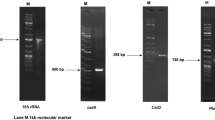Abstract
The adaptive process in bacteria is driven by specific genetic elements which regulate phenotypic characteristics such as tolerance to high metal ion concentrations and the secretion of protective biofilms. Extreme environments such as those associated with heavy metal pollution and extremes of acidity offer opportunities to study the adaptive mechanisms of microorganisms. This study focused on the genome analysis of Bacillus thuringiensis (Bt MCMY1), a gram positive rod shaped bacterium isolated from an acid mine drainage site in Sabah, Malaysia by using a combination of Single Molecule Real Time DNA Sequencing, Scanning Electron Microscopy (SEM) and Fourier Transform Infrared Spectroscopy (FTIR). The genome size of Bt MCMY1 was determined to be 5,458,152 bases which was encoded on a single chromosome. Analysis of the genome revealed genes associated with resistance to Copper, Mercury, Arsenic, Cobalt, Zinc, Cadmium and Aluminum. Evidence from SEM and FTIR indicated that the bacterial colonies form distinct films which bear the signature of polyhydroxyalkanoates (PHA) and this finding was supported by the genome data indicating the presence of a genetic pathway associated with the biosynthesis of PHAs. This is the first report of a Bacillus sp. isolated from an acid mine drainage site in Sabah, Malaysia and the genome sequence will provide insights into the manner in which B. thuringiensis adapts to acid mine drainage.





Similar content being viewed by others
References
Jaenicke R (1991) Protein stability and molecular adaptation to extreme conditions. Eur J Biochem 202:715–728. https://doi.org/10.1007/978-3-642-77200-9_22
Babu P, Chandel AK, Singh OV (2015) Extremophiles and their applications in medical processes. Extrem Bact. https://doi.org/10.1007/978-3-319-12808-5_4
Johnson DB, Schippers A (2017) Editorial: recent advances in acidophile microbiology: fundamentals and applications. Front Microbiol 8:428. https://doi.org/10.3389/fmicb.2017.00428
Van de Vossenberg JLCM, Driessen AJM, Zillig W, Konings WN (1998) Bioenergetics and cytoplasmic membrane stability of the extremely acidophilic, thermophilic archeon Picrophilus oshimae. Extremophiles 2:67–74. https://doi.org/10.1007/s007920050044
Kawashima T, Amano N, Koike H, Makino S, Higuchi S, Kawashima-Ohya Y, Watanabe K, Yamazaki M, Kanehori K, Kawamoto T, Nunoshiba T, Yamamoto Y, Aramaki H, Makino K, Suzuki M (2000) Archaeal adaptation to higher temperatures revealed by genomic sequence of Thermoplasma volcanium. PNAS 97:14257–14262. https://doi.org/10.1073/pnas.97.26.14257
Kawarabayasi Y, Hino Y, Horikawa H, Jin-no K, Takahashi M, Sekine M, Baba S, Ankai A, Kosugi H, Hosoyama A, Fukui S, Nagai Y, Nishijima K, Otsuka R, Nakazawa H, Takamiya M, Kato Y, Yoshizawa T, Tanaka T, Kudoh Y, Yamazaki J, Kushida N, Oguchi A, Aoki K, Masuda S, Yanagii M, Nishimura M, Yamagishii A, Oshima T, Kikuchi H (2001) Complete genome sequence of an Aerobic Thermoacidophilic Crenarchaeon, Sulfolobus tokodaii strain7. DNA Res 8:123–140. https://doi.org/10.1093/dnares/8.4.123
Zhang X, Liu X, Liang Y, Guo X, Xiao Y, Ma L, Miao B, Liu H, Peng D, Huang W, Zhang Y, Yin H (2017) Adaptive evolution of extreme acidophile Sulfobacillus thermosulfodooxidans potentially driven by horizontal gene transfer and gene loss. Appl Environ Microbiol. https://doi.org/10.1128/AEM.03098-16
Marandi R (2011) Bioextraction of Cu (II) ions from acid mine drainage by Bacillus thuringiensis. Int J of Biol Eng 1:11–17. https://doi.org/10.5923/j/ijbe.20110101.03
Oves M, Khan MS, Zaidi A (2013) Biosorption of heavy metals by Bacillus thuringiensis strain OSM29 originating from industrial effluent contaminated north Indian soil. Saudi J Biol Sci 20:121–129. https://doi.org/10.1016/j.sjbs.2012.11.006
Hofte H, Whiteley HR (1989) Insectidal crystal proteins of Bacillus thuringiensis. Microbiol Rev 53:242–255
Frankenhuyzen KV (2009) Insecticidal activity of Bacillus thuringiensis crystal proteins. J Invertebr Pathol 101:1–16. https://doi.org/10.1016/j.jip.2009.02.009
Zhang F, Peng D, Cheng C, Zhou W, Ju S, Wan D, Yu Z, Shi J, Deng Y, Wang F, Ye X, Hu Z, Lin J, Ruan L, Sun M (2016) Bacillus thuringiensis crystal protein Cry6Aa triggers Caenorhabditis elegans necrosis pathway mediated by aspartic protease (ASP-1). Int J Mol Sci 17:1355. https://doi.org/10.1371/journal.ppat.1005389
Raymond B, Federici BA (2017) Perspective in defence of Bacillus thuringiensis, the safest and most successful microbial insecticide available to humanity—a response to EFSA. FEMS Microbiol Ecol. https://doi.org/10.1093/femsec/fix084
Papazisi L, Rasko DA, Ratnayake S, Bock G, Remortel BG, Appalla L, Liu J, Dracheva T, Braisted JC, Shallom S, Jarrahi B, Snesrud E, Ahn S, Sun Q, Rilstone J, Økstad OA, Kolstø A, Fleischmann RD, Peterson SN (2011) Investigating the genome diversity of B. cereus and evolutionary aspects of B. anthracis emergence. Genomics 98:26–39. https://doi.org/10.1016/j.ygeno.2011.03.008
Zwick ME, Joseph SJ, Didelot X, Chen PE, Bishop-Lilly KA, Stewart AC, Willner K, Nolan N, Lentz S, Thomason MK, Sozhamannan S, Mateczun AJ, Du L, Read TD (2012) Genomic characterization of the Bacillus cereus sensu lato species: backdrop to the evolution of Bacillus anthracis. Genome Res 22:1512–1524. https://doi.org/10.1101/gr.134437.111
Christel S, Herold M, Bellenberg S, Hajjami ME, Buetti-Dinh A, Pivkin IV, Sand W, Wilmes P, Poetsch A, Dopson M (2017) Multi-omics reveal the lifestyle of the acidophilic, mineral-oxidizing model species Leptospirillum ferriphilum. Appl Environ Microbiol. https://doi.org/10.1128/AEM.02091-17
Azizli KM, Yau TC, Birrel J (1995) Technical note design of the Lohan Tailings Dam, Mamut Copper Mining Sdn. Bhd., Malaysia. Miner Eng 8:705–712. https://doi.org/10.1016/0892-6875(95)00031-k
Ali MF, Heng LY, Ratnam W, Nais J, Ripin R (2004) Metal distribution and contamination of the Mamut River, Malaysia, caused by copper mine discharge. Bull Environ Contam Toxicol 73:535–542. https://doi.org/10.1007/s00128-004-0462-5
Ali BNM, Lin CY, Cleophas F, Abdullah MH, Musta B (2015) Assessment of heavy metal contamination in Mamut River sediment using sediment quality guidelines and geochemical indices. Environ Monit Assess 185:4190. https://doi.org/10.1007/s10661-014-4190-y
Jopony M, Tongkul F (2009) Acid mine drainages at Mamut Copper Mine, Sabah, Malaysia. Borneo Sci 24:83–94
QIAGEN (2006) Protocol: pretreatment for gram-positive bacteria and purification of total DNA from animal tissues (spin-column protocol). DNeasy Blood Tissue Handb 30–48
Thermo Scientific (2014) Protocol A. Plasmid DNA purification using centrifuges. GeneJET Plasmid Miniprep Kit
Chang Y, Hahn S, Kim B, Chang H (1994) Optimization of microbial poly (3-hdroxybutyrate) recovery using dispersion of sodium hypochlorite solution and chloroform. Biotechnol Bioeng 44:256–261. https://doi.org/10.1002/bit.260440215
Singh P, Parmar N (2011) Isolation and characterization of two novel polyhydroxybutyrate (PHB)-producing bacteria. Afr J Biotechnol 10:4907–4919. https://doi.org/10.5897/AJB10.1737
Department of the Environment (1993) Code of practice for agriculture use of sewage sludge
Miller KW, Risanico SS, Risatti JB (1992) Differential tolerance of Sulfolobus strains to transition-metals. FEMS Micriobiol Lett 93:69–72. https://doi.org/10.1016/0378-1097992)90491-6
Walkin ELJ, Keeling SE, Perrot FA, Shier DW, Palmer ML, Watling HR (2008) Metals tolerance in moderately thermophilic isolates from a spent copper sulfide heap, closely related to Acidithiobacillus caldus, Acidimicrobium ferroxidans and Sulfobacillus thermosulfidooxidans. J Ind Microbiol Biotechnol 36:461–465. https://doi.org/10.1007/S10295-008-0508-5
Li Q, Xu LZ, Ai P, Huang GH, Li P, Zheng AP (2015) Complete genome sequence of Bacillus thuringiensis strain HD521. Stand Genom Sci 10:62. https://doi.org/10.1186/S40793-015-0058-1
He J, Wang J, Yin W, Shao X, Zheng H, Li M, ZhaoY Sun M, Wang S, Yu Z (2011) Complete genome sequence of Bacillus thuringiensis subsp. chinensis strain CT-43. J Bacteriol 193:3407–3408. https://doi.org/10.1128/jb.05085-11
Murawska E, Fiedoruk K, Bideshi K, Swiecicka I (2013) Complete genome sequence of Bacillus thuringiensis subsp. Thuringiensis Strain IS5056, an Isolate highly toxic to Trichoplusia ni. Genome Announc 1:e00108-13. https://doi.org/10.1128/genomea.00108-13
Sheppard AE, Poehlein A, Rosenstiel P, Leisegang H, Scholenburg H (2013) Complete genome sequence of Bacillus thuringiensis Strain 407 Cry. Genome Announc 1:e00158-12. https://doi.org/10.1128/genomea.00158-12
Liu Y, Lai Q, Göker M, Meier-Kolthoff JP, Wang M, Sun Y, Wang L, Shao Z (2015) Genomic insights into the taxonomic status of the Bacillus cereus group. Sci Rep 5:14082. https://doi.org/10.1038/srep14082
Sarrafzadeh MH, Bigey F, Capariccio B, Mehrnia M, Guiraud J, Navarro J (2007) Simple indicators of plasmid loss during fermentation of Bacillus thuringiensis. Enzyme Microb Technol 40:1052–1058. https://doi.org/10.1016/j.enzmictec.2006.08.030
Oshima T, Arakawa H, Baba M (1977) Biochemical studies on an acidophilic, thermophilic bacterium Bacillus acidocaldarius: isolation of bacteria, intracellular pH and stabilities of biopolymers. J Biochem 81:1107–1113. https://doi.org/10.1093/oxfordjournals.jbchem.a131535
Futterer O, Angelov A, Liesegang H, Gottschalk G, Schleper C, Dock C, Antranikian G, Liebl W (2004) Genome sequence of Picrophilus torridus and its implications for life around pH 0. Proc Natl Acad Sci USA 101:9091–9096. https://doi.org/10.1073/pnas.0401356101
Baker-Austin C, Dopson M (2007) Life in acid: pH homeostasis in acidophiles. Trends Microbiol 15:165–171. https://doi.org/10.1016/j.tim.2007/02.005
Bowra BJ, Dilworth MJ (1981) Motility and chemotaxis towards sugars in Rhizobium leguminosarum. J Gen Microbiol 126:231–235. https://doi.org/10.1099/00221287-126-1-231
Lauffenburger D, Aris R, Keller K (1982) Effects of cell motility and chemotaxis on microbial population growth. Biophys J 40:209–219. https://doi.org/10.1016/s0006-3495(82)84476-7
Fujinami S, Terahara N, Krulwich TA, Ito M (2009) Motility and chemotaxis in alkaliphilic Bacillus species. Future Microbiol 4:1137–1149. https://doi.org/10.2217/fmb.09.76
Acuna J, Rojas J, Amaro AM, Toledo H, Jerez CA (1992) Chemotaxis of Leptospirillum ferrooxidans and other acidophilic chemolothotrophs: comparison with the Escherichia coli chemosensory system. FEMS Microbiol Lett 96:37–42. https://doi.org/10.1016/0378-1097(92)90453-u
Moreno-Paz M, Gomez MJ, Arcas A, Parro V (2010) Environmental transcriptome analysis reveals physiological differences between biofilm and plantonic modes of life of the iron oxidizing bacteria Leptospirillum spp. In their natural microbial community. BMC Genom 11:404. https://doi.org/10.1186/1471-2164-11-404
Zhang X, Feng X, Tao J, Ma L, Xiao Y, Liang Y, Liu X, Yin H (2016) Comparative genomics of the extreme acidophile Acidithiobacillus thiooxidans reveals intraspecific divergence and niche adaptation. Int J Mol Sci 17:1355. https://doi.org/10.3390/ijm17081355
Jiao Y, Cody GD, Harding AK, Wilmes P, Schrenk M, Wheeler KE, Banfield JF, Thelen MP (2010) Characterization of extracellular polymeric substances from acidophilic microbial biofilm. Appl Environ Microbiol 76:2916–2922. https://doi.org/10.1128/AEM.02289-09
Llamas I, Amjres H, Mata JA, Quesada E, Bejar V (2012) The potential biotechnological applications of the exopolysaccharide produced by the halophilic bacterium Halomonas almeriensis. Molecules 17:7103–7120. https://doi.org/10.3390/molecules17067103
Nocelli N, Bogino PC, Banchio E, Giordano W (2016) Roles of extracellular polysaccharides and biofilm formation in heavy metal resistance of Rhizobia. Materials. https://doi.org/10.3390/ma9060418
Keshavarz T, Roy I (2010) Polyhydroxyalkanoates: bioplastics with a green agenda. Curr Opin Microbiol 13:321–328. https://doi.org/10.1016/j.mib.2010.02.006
Strong PJ, Laycock B, Mahamud SNS, Jensen PD, Lant PA, Tyson G, Prat S (2016) The opportunity for high-performance biomaterials from methane. Microorganisms. https://doi.org/10.3390/microorganisms4010011
Singh M, Kumar P, Patel SKS, Kalia VC (2013) Production of polyhydroxyalkanoate co-polymer by Bacillus thuringiensis. Indian J Microbiol 53:77–83. https://doi.org/10.1007/s12088-012-0294-7
Zubairi SI, Mantalaris A, Bismarck A, Aizad S (2015) Polyhydroxyalkanoates (PHAs) for tissue engineering applications: biotransformation of palm oil mill effluent (POME) to value-added polymers. Jurnal Teknologi Science Engineering 78:13–29. https://doi.org/10.11113/jt.v78.4042
Gomaa EZ (2014) Production of polyhydroxyalkanoates (PHAs) by Bacillus subtilis and Escherichia coli grown on cane molasses fortified with ethanol. Braz Arch Biol Technol 57:145–154. https://doi.org/10.1590/S1516-89132014000100020
Hong K, Sun S, Tian W, Chen GQ, Huang W (1999) A rapid method for detecting bacterial polyhydroxyalkanoates in intact cells by fourier transform infrared spectroscopy. Appl Microbiol Biotechnol 51:523–526. https://doi.org/10.1007/s002530051427
Gupta S, Madan RN, Bansal MC (1987) Chemical composition of Pinus caribaea hemicellulose. Tappi J (USA) 70(8):113–116
Acknowledgements
This research was funded by the Government of Malaysia, Ministry of Higher Education, Fundamental Research Grant Scheme. Project title: Molecular Characterization of the Bacterial and Archaeal Diversity of Mamut Copper Mine (FRG0455-TWN-1/2016). The authors wish to acknowledge the collaboration provided by the Department of Mineralogy, State Government of Sabah, Malaysia.
Author information
Authors and Affiliations
Corresponding author
Ethics declarations
Conflict of interest
The authors declare that they have no conflict of interest.
Rights and permissions
About this article
Cite this article
Yik, L.Y., Chin, G.J.W.L., Budiman, C. et al. Adaptive Strategies of Bacillus thuringiensis Isolated from Acid Mine Drainage Site in Sabah, Malaysia. Indian J Microbiol 58, 165–173 (2018). https://doi.org/10.1007/s12088-017-0701-1
Received:
Accepted:
Published:
Issue Date:
DOI: https://doi.org/10.1007/s12088-017-0701-1




